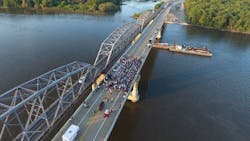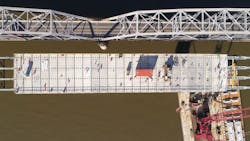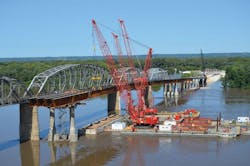NO. 5 BRIDGE: Champ Clark Bridge over the Mississippi River (U.S. Hwy 54)
Originally completed in 1928, the Champ Clark Bridge—so named for a former Missouri Speaker of the House—stood as a landmark along the Mississippi River for nearly a century.
But like all man-made creations, its serviceable life eventually and inevitably came to an end—and a new alternative was required. The bridge linked Louisiana, Missouri, an area of rolling hills that feature quite a lot of agricultural development, with Pittsfield, Illinois, where the soils are classically rich river bottom soils, ideal for farming. Its replacement structure now carries the same burden of community connection. What was once just 20 ft wide, with extremely narrow 10-ft shoulderless travel lanes now boasts a pair of 12-ft driving lanes and 10-ft shoulders in each direction, more than doubling the traversable width. For a rural area that has farming equipment as a regular part of the overall traffic mix, this improvement has been long overdue.
We first covered this bridge replacement project in our May 2019 issue. At that time, contributing author Lisa Schoolcraft quoted Missouri DOT Project Director Keith A. Killen as saying, “‘When combines go across, the police shut down the bridge. This also happens frequently with large loads. The new bridge will be an amazing improvement for the community.’”
Right he was. Roads & Bridges had the chance to speak with Killen recently about this project, and now that the bridge is open to traffic, he touted the safety improvements the new structure offers.
“There weren’t necessarily backups on the old bridge,” he said. “Traffic is light enough at about 4,200 vehicles per day that it was usually just a matter of things slowing down. The old bridge had a posted speed limit of 30 mph, and people would often drive slower than that over it. But there were some crashes, though it didn’t rise to a level of being worse than other river crossings. What there were a lot of were side swipes and mirrors getting clipped off due to the narrow lanes. With the wider lanes and shoulders, we expect to see that greatly reduced.”
Due to the length of the cross-river spans, designers opted for steel girders over precast concrete, though precast did come into play elsewhere in the project. “It made more sense to use steel on the river spans,” Terrence J. Colombatto, project manager for contractor Massman Construction Company, told Roads & Bridges. “The spans range from 260 ft to 420 ft in this area, and had we chosen concrete on those spans, we would have had to shorten the spans or go with a post-tensioned spliced concrete girder. We also would not have been able, likely, to reduce the piers in the river. But we did use precast on the approach spans. There are three approach spans we used concrete girders on.”
With any river construction there is always the risk of flooding, and crews did experience the second highest recorded river flow in the Mississippi’s history this past summer. It was something Massman had to perpetually contend with; however, the reduction in the number of in-river piers did make the river work somewhat less difficult than it might otherwise have been.
“We were able to eliminate one of the piers,” Colombatto said. “The old bridge had five in the river, we have four, which was nice as it reduced the impact of displaced water and flow, and helped us achieve the no-rise criteria that was set by the U.S. Army Corps of Engineers.”
Massman used large, 11-ft-diam. drilled shafts in the piers, which enabled a reduction in the number of shafts per pier and aided the project from a cost-savings perspective. It was one of several means Massman employed to optimize and improve the project timeline.
“We asked ourselves how can we enhance this project?” Colombatto told Schoolcraft. “What bells and whistles can we give them? We included some little things that would enhance the project, like adding roadway lighting to the intersection at the west end of the project. We proposed to give them a polyester polymer overlay on the deck of the bridge. That was a big selling point. And we added 10-ft shoulders to each side of the bridge. We carried the shoulders not only on the bridge but over on the Illinois roadway as well.”
Another cost and time saver was using precast deck panels. Designer HNTB Corp. had used precast deck panels before on other projects; the benefit to the Champ Clark Bridge project was to keep it on schedule. A total of 181 precast deck panels were used in the construction of the new bridge. Each deck panel was 46 ft wide, extending to the full width of the bridge.
Since our initial coverage, crews have completed the deck portion of the superstructure, the concrete barriers, all paving on the approaches, guardrail installation, and striping. The new bridge was opened Aug. 3 to much public fanfare. “The great grandchildren of Champ Clark himself were on hand for it,” Killen said, “along with 600 other people.”
The demo of the old structure was underway as of this writing, with deck removal complete. By the time you read this, the old trusses will be a thing of the past.


